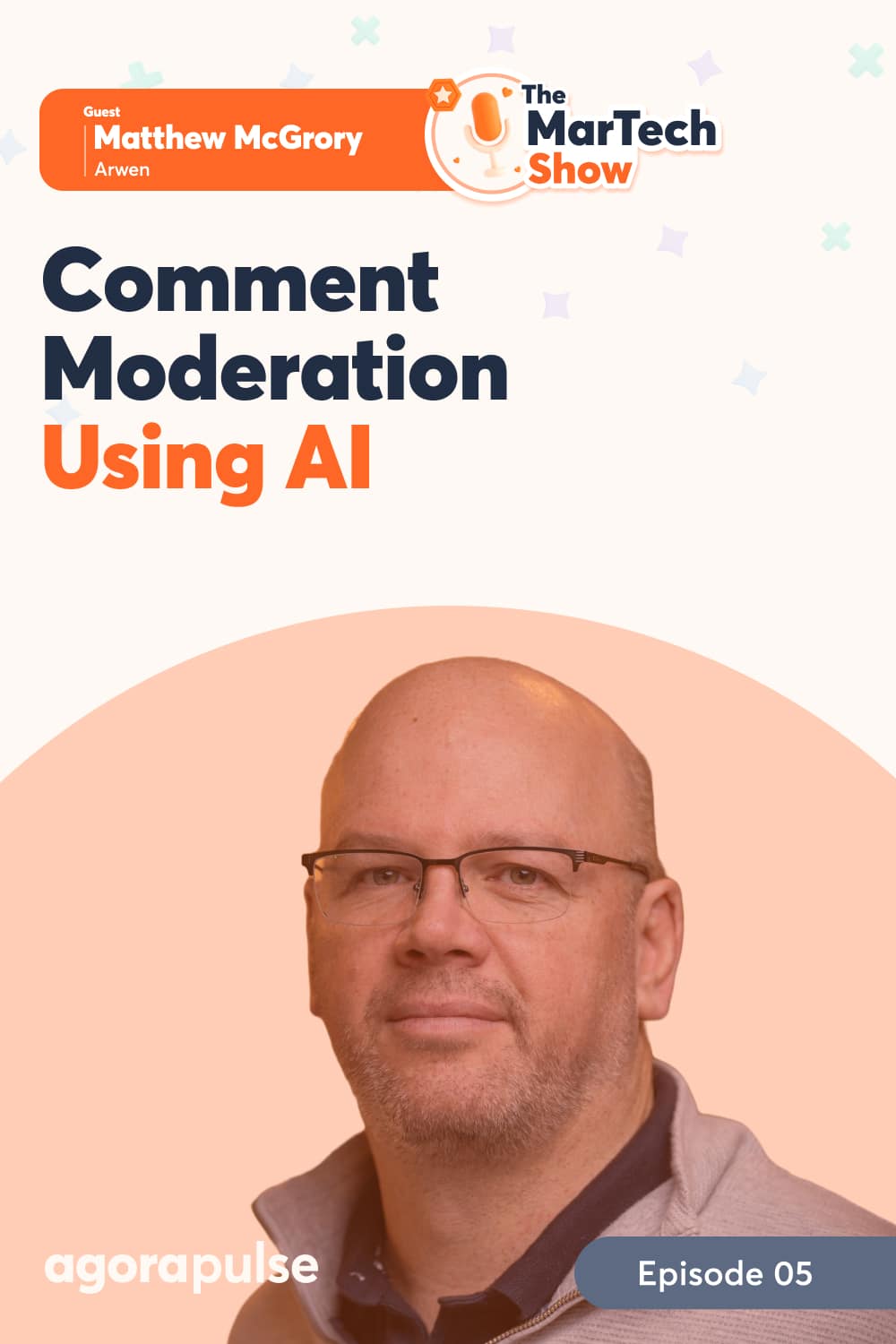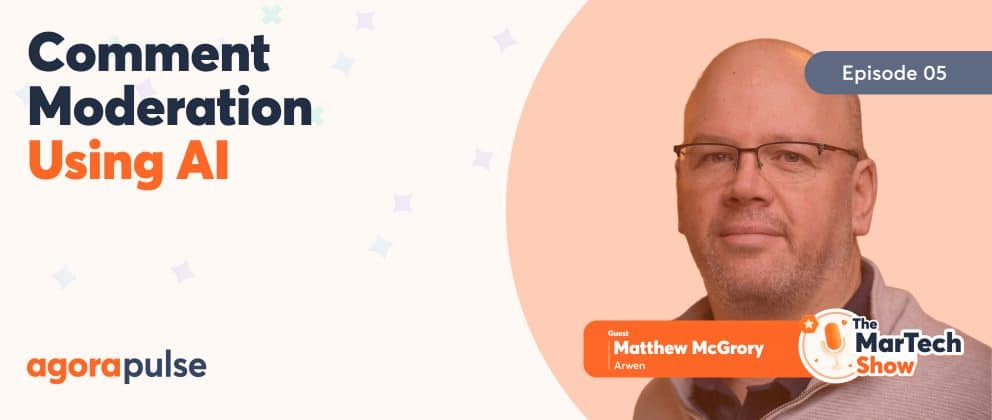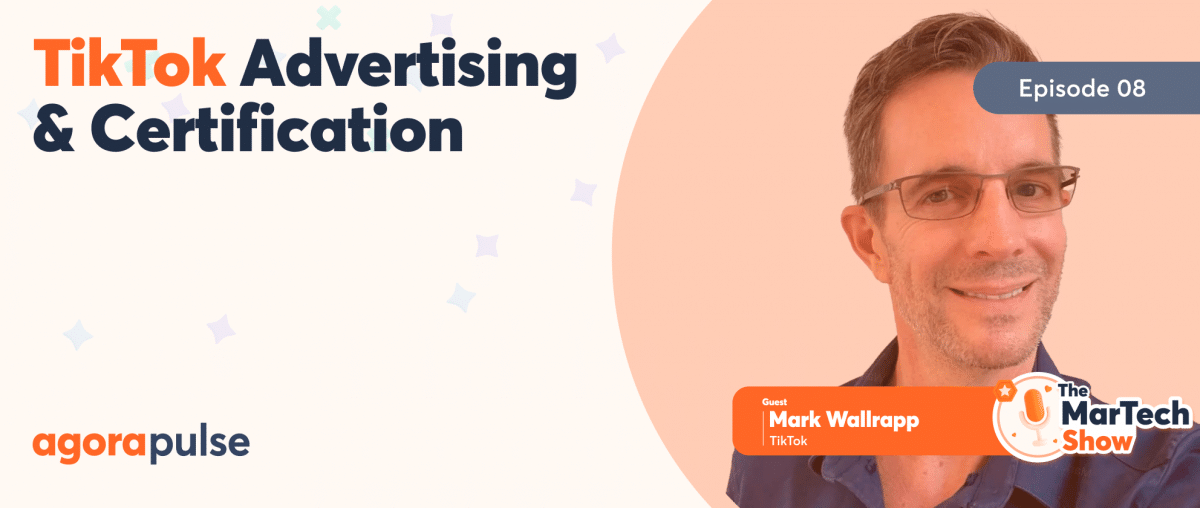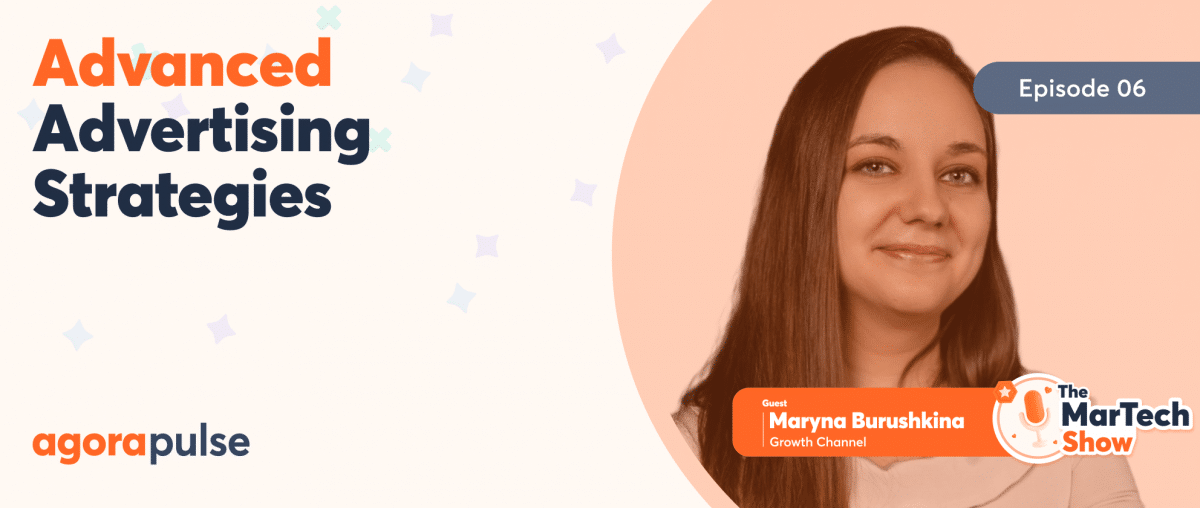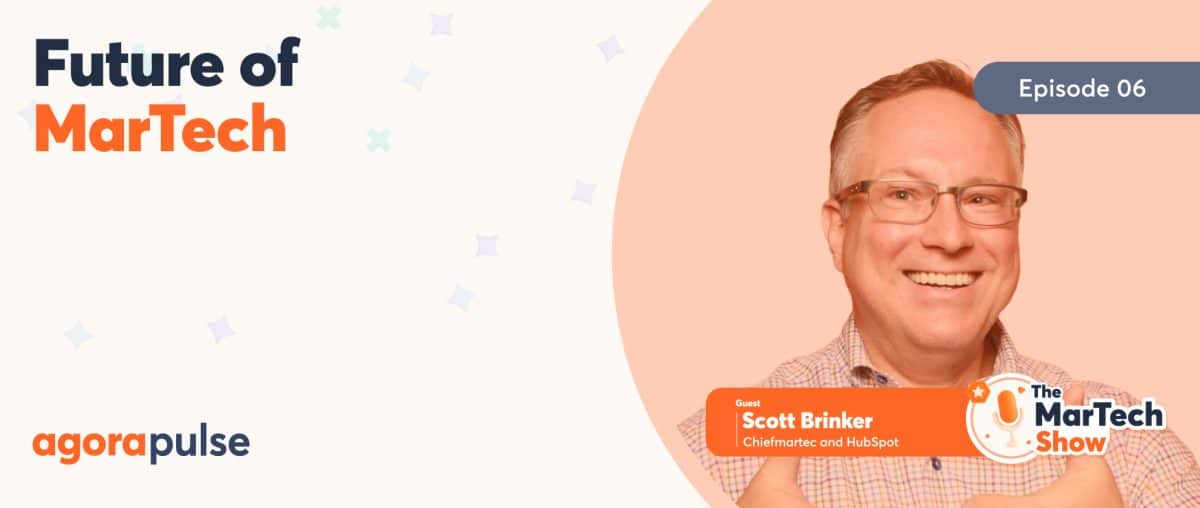According to research from Microsoft, 74% reports that the perception of a brand improves when it’s clear the company responds to customer social media queries. And yet the average response rate for brands is only 7%.
Why are so many companies failing to engage with and deal with comments on social media and—more importantly—for agencies or large brands who are seeing tremendous volume? How are they supposed to keep up with and moderate all those comments?
That’s what we’re covering in today’s episode of The MarTech Show, where Robin and I get to dish on what’s shiny and new in the MarTech space, and then do a deep dive into a specific platform or solution that can help you and your business today.
You can listen to the entire podcast immediately below or read on for the highlights.
MarTech News: Meta’s New Gen AI
Now this week, Meta introduced some new Gen AI-powered features, allowing advertisers to automate the creation of text and images and ads on the company’s social platforms. We’re talking about Facebook, Instagram, WhatsApp, now new tools and features. They’ll be added incrementally, but the aim is to have them available globally by the end of the year.
But there’s some stuff it can do today. The current text creation tool creates variations of ad headlines and body, and the ability to create text that fits specific brand’s voice and tone, while suggesting key selling points to include in the ads’ message. From an image perspective, ad managers and marketers can generate variations on existing creative. They can use tools to change backgrounds around images or stretch out the image to fit multiple parameters.
For instance, image expansion is now available to fit images on Reels and feed ads across both Instagram and Facebook. And in the coming months, users will be able to create images from text prompts, according to Meta. What’s your take on this, Robin?
Robin Dimond: I think it’s absolutely amazing. I mean, you said it earlier today: We can’t keep up with all the things that are happening.
How are you supposed to keep up with so many platforms, so many changes? And so Meta doing this is allowing us to kind of embrace our brand and change it up to be more personalized. We’re seeing it. And I always tell everyone, “If you’re not cheating, you’re not trying,” which is using ChatGPT—but seeing AI be involved in all of these is really helping us get to know our audiences.
Mike Allton: Totally agree. And using AI to help with editing and modifying is one thing. Using AI to completely generate ad copy and creative seems like something else entirely, but that’s certainly the direction that MarTech tools are going right now.
MarTech Day
Now in other tool news, the first Tuesday of May, was MarTech Day, for those who celebrate. That’s the day that Scott Brinker of Chief MarTec.com and HubSpot releases his annual report on the state of Martech industry and how much development there’s been since the previous year. So, we’re going to bring Scott into the studio next week for a special podcast-only edition of the MarTech show to break down everything that’s happening with marketing technology.
So, make sure you subscribe to the podcast on your favorite podcast player so you don’t miss out. But spoiler alert: The report reveals a massive 27 percent increase year over year in new marketing technology.
Just mind-blowing how many tools and apps are out there and the capabilities that are being developed with this proliferation of tools comes both good and bad. Automation brings out folks who look for opportunities to cut corners and abuse systems. Like Robin said, if you’re not cheating, you’re not trying. And one of those areas is in comments.
Introducing Matthew McGrory and AI Comment Moderation
There are so many tools today that allow bad actors to spam all kinds of comments on our brand and our social media posts.
But it’s not all bad. Many brands have achieved sufficient reach and audience to enjoy tremendous levels of organic commentary from fans and clients. The trouble is that high volumes of comments and questions can easily overwhelm social media managers, support staff, and agency representatives.
So, how do we keep up?
And how can we better leverage and elevate all the great, positive comments that are being left?
That’s exactly what Matthew McGrory is going to talk to us about. Matt is the CEO and the co-founder of Arwen AI Limited, a tool to help enterprise brands revolutionize their social conversations. Arwen uses market-leading AI to put you in control of your social media, paid and organic comments, automatically removing spam and toxic comments, detecting and managing negative comments, and spotting the opportunities to amplify the positive.
Why Brands Need Comment Moderation
Mike Allton: Let’s just dive right in.
Why is comment moderation really needed today, and what kinds of brands or profiles seem to have the most need?
Matthew McGrory: In our experience, the brands or profiles are plentiful. Anyone that is making a living online or anyone that’s looking to project their brand in a safe and secure way, which would include typically B2C businesses, online brands, influencers. We find, specifically, a lot of clients we have are in the elite sports organizations, broadcastings, and we find there are typical things that can generate, obviously, large comments. They come with accounts that have large followers. Typically, it can be any organization that’s got a very strong B2C public-facing audience.
And we also see people spending lots on ad spend and want to protect that ad spend from being hijacked by a contrabrand position. And we also find people that are expressing a kind of diversity objective, around what they’re doing. Taking a stand or a position on something that might have an oppositional stance.
If you want to protect your asset that you are investing in, which is your social media, we think it’s really important to think about this long and hard.
Robin Dimond: I mean, we’ve all been there. We’ve all been the people on the other side of the comments and you said, if you’re investing heavily, those comments just pour in.
So what is the risk to a brand if they’re not mentioning all these comments if they’re not going through them?
Matthew McGrory: So, if you’re not editing the toxic comments, you’re basically leaving them out there, and the position is changing because the public knows that you could do something about it. Tools like Arwen are reasonably becoming more prevalent in the marketplace. So end users, people that consume social media are going, “Well, there are solutions to this problem.” You can do something about it.
You don’t need to have toxic and spam and unwanted content and commentary sitting on your channels. And very quickly, partners of brands are realizing this.
They’re demanding, “If I’m going to sponsor you, or I’m going to sponsor your brand or your site or have my consumer goods posted on your site. I don’t want to be associated with this stuff. I want to be in a place where there’s positivity, and there’s a positive thriving community.” That’s the kind of real firm point.
The other point is that there’s an ethical, moral obligation. People wouldn’t put up with this in the real world. If we were sat around as humans sitting in a room, you call it out. So why don’t people want to call it out of line?
The last point is it damages your engagement. The stats are: The research shows something like 47 percent of people will disengage with your brand if you leave up toxic and threatening and violent language [on your comment section/website/socials].
And it’s disproportionately to women, so brands that really want to engage with women. Women don’t like threatening language, violent language. They will leave your brand if you leave those sorts of comments out there.
Mike Allton: 100%. You never know who is looking.
As the brand who’s getting this engagement on your social media posts, if you’re not filtering those out and staying on top of those, you might be missing out on actual business that you had no idea was there in the comments and paying attention.
But for a brand that maybe is not used to this, maybe they haven’t been investing a lot in paid, and now they’re going to start to accrue this kind of commentary. Or maybe they’re suddenly finding themselves in an industry like AI that is suddenly booming, and it wasn’t necessarily a few years ago and they’re getting a lot of comments and engagement when it comes to processes and policies.
Openness and Transparency in Your Comment Section
Matt, how do you recommend brands like that never dealt with this? How do you recommend they get started?
Matthew McGrory: So our approach? We went on a massive learning curve here. We had a Premier League soccer club in the UK as one of our first clients. And we went live with auto-moderation of their commentary comment feeds without any announcement.
We didn’t do any PR around it. We didn’t put a policy in place. And it didn’t go well because the fans were like, “Well, what’s going on? You’ve never hidden me before why are you hiding me now?” So we quickly learned that you need to be absolutely open about this. You need to be very clear.
There are different jurisdictions to consider as well. So, I’m talking to you from the UK. We’re just implementing the online safety bill here in the UK. The EU has just implemented the DSA. There are a few states in the US that are putting in their own legislations. There’s no federal legislation as yet on it, but it’s being talked about in the US. It may not be far off. See what happens in November on that regard.
But we very much advocate an open expression of what you’re doing. Because 99 percent of your audience and your community wants the protection, and what the transparency and the policy does is it allows you to take action on things within the guidelines of that policy without anyone being able to say, “You’re censoring, you’re stopping my freedom of speech.” No, we’re not.
We’ve made some clear guidelines. These are the things we accept on our commentary. These are the things we don’t accept. And if you do these things, we reserve the right to hide the comments. And if you carry on doing it, we reserve the right to comment to block you from our community, and not be there anymore.
We really say you need to tell people what you’re doing. Never do it in secret. People will find out and they’ll call you out.
Robin Dimond: Well, transparency. We talk about that all the time here and how important it is. You can’t, you can’t hide those. And I’m glad that you brought that up as a point. So let’s talk about technology.
How Does Arwen Help with the Comments?
Matthew McGrory: We have a couple of products.
Our flagship product that we’ve been start-up going about four years now is an auto-moderation tool. And we would basically connect us to your socials. Other marketing technology tools authorize us to collect your comments. We analyze them against up to 30 AI models that we have running in the background. We normally work with the brand or the individual to create the brand voice in the AI so we remove comments that you 100% don’t like, which we call severe. Any safe comments we let through.
And then we have this kind of the nod to the machine, because the machine is never perfect, and any AI company that tells you otherwise is not being totally honest. So we have what we call the suspect queue, which is if you can, you can go in here—and this is normally somewhere between 1% and 2% of the comments on there—and just kind of check, “Has the machine missed some things that I would’ve blocked? And can we teach the AI to make better decisions next time?” And we put that in the feedback loop on behalf of clients.
That’s our main moderation tool that typically just runs in the background and hopefully seamlessly fixes the problem and typically we will deal with world events as they happen. We’ll create different type of comments and commentary that we haven’t seen before, such as the kind of Israel-Gaza conflict, and people want to take different positions on those types of things, and that we’ll need to teach the AI how people wanted to handle those types of things.
So, it’s an ongoing job to keep on top of it.
We cover both paid and organic. Facebook, Instagram, X, YouTube, and TikTok, we cover on the organic side. And then for the ads, we cover Instagram, Facebook, and TikTok, and we cover all the different nuances. There’s a bit of a nuance around UGC-type content where a brand is paying to boost an influencers post. So you need the permission of the influencer to kind of protect them. We cover a global dating app, and they do a lot of campaigns—as you can probably suspect—for the LGBTQ community where they were getting homophobic abuse on the influencers, ads, and we were cleaning them. We have to get the permission of them to moderate comments on that on their ads.
That’s basically it, across all those social media channels.
Implementing AI to Sort Through Comments
Mike Allton: You mentioned how you were using AI earlier to help kind of screen comments and the engagement that’s coming in.
Can you unpack a little bit more about specifically how is AI really, really powering Arwen to surface these kind of comments? And if there’s anything else you can share about how AI is being implemented there?
Matthew McGrory: There’s probably a few things.
- What we found is there’s a big problem with spam on social media that I think everyone that uses or posts or deals with social media knows about, and it goes in waves on different channels. We found there wasn’t any AI, that particularly addressed that problem. So, we had to build our own.
- Most of the models we get around things like racism or homophobia, sexism, or misogyny are all very well researched kind of types of abuse. And so there are lots of open source models and proprietary models that we can buy-in or ingest into our platform.
- Spam was different. It doesn’t exist. We were doing what we call a word-based and sentence structure-based detection of spam, which got us to about 95 percent accuracy. We’ve recently implemented analysis of profiles across Meta. So, this is where we’re ingesting the picture.
- Maybe there’s a link on Pornbots. You get a dating link that tries to get your audience to go off to another site. The picture might be of a certain type, typically on Pornbots. Someone might be in a bikini. So, there are very often tell factors as to whether this might be a crypto scam type spam or a Pornbot type scam. And so we’re using a collection of all those different instruments to pull that together. So, that’s sort of on the negative side and cleaning stuff up.
- The other thing we’re doing is trying to get AI to talk more in the brand voice of our clients. So we’re using a relatively new technique that emerged out of the Facebook labs called Retrieval Augmented Generation or RAG.
- This is where you use this technique in tandem with large language models to create those people that have used large language models. They come with a expiry date of all the data that has been put into those models. Typically, the responses you get will be generic.
- And what we try and do with RAG is couple the large language model with your data and your frequently asked questions, or it might be your policies. One thing we did was around what’s your data retrieval policy, which differs from company to company, so can’t be generic, so we’d use that so that the large language models are giving bespoke questions that sound like the brand, and they’re on brand, and then they’re in the colloquialisms.
These are a couple of things we’re doing, and we’re doing that to generate auto response type stuff.
We’re doing that on review recommendation responses on app stores, on review sites, and things like that to fast track responses for brands in those environments.
Robin Dimond: I think this is so important in what you’re talking about. And I think that’s great. And as an agency owner, I think: How can we benefit from this? Because I know how time-consuming this can be, but I’d love for you to share, like, how can we use it and benefit from Arwen?
How Agencies Can Benefit
Matthew McGrory: Typically, with agencies that with a performance agency or someone that is a full service marketing agency, we would typically see them managing some of the ad spend.
And we were dealing with a US-based global, dating agency, and we found a 19 percent reduction in their customer acquisition costs by removing toxic commentary off their ads and keeping them clean.
In their case, they were spending seven-figure sums. This represented an enormous saving for them. So, for me, it’s like, “How can we help the agency do what they do best, which is recommend the best way and to deliver the best kind of ad campaign possible for the client?”
The other thing is how do we create engagement?
So, responding to comments, some of the stats, some of the performances we’ve done, you can get a nine point, not 0.9 point boost on the App Store Google Play for your app if you just respond. So, we did a AI analysis of people who will post one-star reviews, but they’ll generally be a positive review. So we pull that out, we give that to the client, and we say, “Here’s a response.”
This is how we respond to it, and they can hear it. They can go and respond that, and we can auto respond that.
That value there is advising the client on, like, “These are things you have to do. You were just talking about this 7 percent engagement and response to comments.” It’s not social media if you’re doing that. It’s just media. It’s just like having a website, and you’re just putting content up and hoping the right thing happens. This is a place where you can control the conversation. You can direct it. You can direct it to the things that you want to be said.
Mike Allton: You’re so right. There’s this definite incorrect perception of how brands could and should be using social media. They’re not using it for engagement. They’re not using it to be social.
I love that you talked about turning social media from a cost center into a profit center. That’s something we talk about a lot at Agorapulse because we focus on being able to share links in these kinds of comments in the posts and the direct messages that are all tracked. And so when someone’s sharing a link to something to be purchased on someone else’s shop, they can track that actual purchase and attribute it to that particular social post.
But one thing that you just glossed over that I’d love you to kind of unpack a little bit more is the fact that you do have tools built in to help with the actual responses. So, talk to us about that aspect a little bit more. And then other than dealing with just the negative comments and the spam, are there other use cases for Arwen that brands and agencies should be aware of?
Tools to Know
Matthew McGrory: We have a tool called Engage, which is kind of exactly as it does.
We will surface the happy comments from your community. So, we did a project for a UK pub chain. They have 2,400 bars. Loads and loads of Instagram and Facebook accounts, about 4,000. And they wanted to get an overall picture a social listening thing of what’s going on, but they also want to respond to them: Who’s asking me questions? Who wants to know things about my service, my food, and where do I go?
When you’ve got that many accounts and a very disparate kind of organization structure that sent the people to you potentially centralized in how they respond, respond to this stuff. So bringing that all into one central place and then helping them find the needles in the haystack. What are the positive things? We can use an emotion AI to detect questions and joyful content. “Who’s being happy about my food? I might want to give a voucher to someone who is disgusted by my food, and I might have a customer service problem, and I want to dive into that.”
We integrate into lots of third-party tools that have open APIs similar to how Agorapulse works and to try and find those needles in the haystacks and put them in whatever tool our clients are using as their inbox, which could be a myriad of different third-party tools. That’s our engagement product.
And then I’ve mentioned about what we call our customized product, which is really using that kind of RAG technique to create the AI model that detects the needle in the haystack that’s important for that brand. We spoke to a global brand that was concerned about plastic from their product being put in the sea and people talking about that and they don’t know about all the good work that that they are doing as an organization to remove plastic from the sea and save dolphins and save the whales etc. So, they want to put that message out there.
The Future Roadmap
Robin Dimond: That’s awesome. So, with all of the new changes you’re doing, so what’s on the roadmap for this next year?
Matthew McGrory: Well, I think the main thing in our world is probably mapping out our personal scope.
- We’ve seen a lot of people in the gaming sector, we don’t cover things like Twitch, we don’t cover Reddit.
- There’s some kind of platform growth. That’s what we’re specifically going to be doing. We’re also reaching out into the Engage product into new places. We’ve just done the Google Play Store. We’re doing the App Store reviews. We’ve got an engagement with a broadcaster to help them Trustpilot responses, and you think Google Reviews, things like that. That’s where we’re headed on that roadmap. It’s normally a one conversation, so someone posts a review and you want a response, so it’s a little bit more simple than the kind of three or four responses you might need to have a social media conversation.
- We work with a lot of Formula One teams and helping them on race weekends, for example. Understand what people are saying every 15 minutes during a Formula One race, like they had last weekend in Miami. So, that’s kind of what we’re doing with Red Bull and Mercedes and those types of teams. It’s a very quick, reactive, “What are people saying? What’s the emotion? What’s the sentiment being said? And how should I respond to that?” Because sometimes you need that information, in their case, to give to drivers to make a comment in a press conference that influences online behavior.
It’s about how do we we join the offline with the online and make them influence each other and join up in a positive way for the brand?
Getting Connected with Matthew
Mike Allton: Matt, you’ve been amazing. This has been such a deep dive into this topic that I know a lot of people need to know more about. If they wanna learn more from you or from Arwen, where can they go to connect and find you?
Matthew McGrory: They can find us on our website at Arwen.ai. You can email me at MATTHEW@Arwen.ai, and I’d love to answer any questions anyone’s got.
Thank you for listening to another episode of the MarTech Show hosted by Robin Dimond and Mike Allton, powered by Agorapulse, the number one rated social media management solution, which you can learn more about at Agorapulse.com.
If you want to make sure you’re part of our audience during live weekly broadcasts, take a look at our calendar at agorapulse.com/calendar, or click the subscribe button in your email. Once you register for any of these events, is there a particular tool or topic you’d like to see us talk about? Or perhaps you think your solution should be featured? Email Mike@agorapulse.com.
